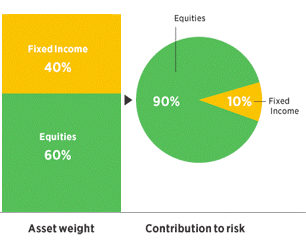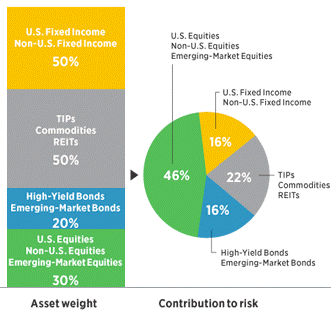Dynamic Risk Allocation
Putnam Investments came out with a new fund last month, called Dynamic Risk Allocation Fund (PDREX). The fund “pursues total return like a traditional balanced fund, but with a better balance of risk. This investment approach is called Risk Parity. Rather than letting equities dominate, the risk is spread more evenly across a flexible variety of sources.”
It is an interesting approach and it touches several key portfolio investment practices, such as total return, risk balance, and risk parity. In the current uncertain economic environment and stock market gyrations, these concept certainly sound good. Not only that, the fund name “Dynamic Risk Allocation” is very sexy and would certainly catch anyone’s attention (it certainly caught mine). So are these just buzz words or are these concepts important and does this fund merit our focus.
None of the above terms have a precise definitions, but I will attempt to put things in perspective and explain what I generally believe defines each term. The Total Return typically refers to a return on the asset that is derived from both capital gains and dividends. In other words, the focus of a Total Return strategy is to hold various assets that on balance will provide return from growth in the price of that asset, as well as income that comes from this asset, such as dividends if stocks, and interest payments if bonds. Sometimes this could also be called a “balanced” approach.
The Risk Balance refers to allocating portfolio based on individual asset risk, versus individual asset expected return. A typical portfolio that has a standard 60/40 allocation of stocks/bonds will have a disproportionate risk coming from equities in the portfolio, rather than bonds. A typical 60/40 portfolio may provide a higher overall return, but lower risk adjusted return. In other words to earn that return you would have to take on larger amount of risk on a per unit basis. The way to measure risk adjusted return is to calculate the Sharpe ratio of the portfolio. Putnam has a nice diagram that describes this.
Source: Putnam Investments
The Risk Parity refers to, and that is where PEDRX gets its name, dynamic risk allocation. Dynamic risk allocation means several things, first is that you shift your positions based individual asset’s risk contribution to the portfolio and as that changes so does the weight of the asset in the portfolio. Second, you spread the risk, through portfolio positions, among many different asset classes, such as equities, bonds, international equities and bonds, emerging market equities and bonds, real estate, commodities, and alternative hedge fund type strategies. I wrote several times about this approach on the pages of TheStreet.com. Putnam has a nice graphic representation of this as well.
Source: Putnam Investments
In addition to that, Risk Parity, which is sometimes called Equal Risk Contribution, provides for dynamically shifting positions based on respective risk contributions of each holding as markets become more or less risky. In other words, as the markets become more risky, the portfolio would have higher allocation to less risky assets and vice versa.
So overall this fund has many nice features for us, more conservative investors. I like the balanced approach of Total Return, I like the risk adjusted approach to returns of Risk Balancing, and I like the dynamic active management of the portfolio of Risk Parity. All good news, but…
I started looking at fund details and I did not like what I found. Fund fee is set at hefty 2.12%, but the management decided to contractually limit expenses to 1.40% through September of next year. This fee is something we could generally live with if the performance is there. In addition to that, this is a very active portfolio and requires a vigorous and committed fund manager, so I am willing to pay for a good job.
But what is bothersome is the levy of the sales charge of 5.75% for investment size up to $49,999, decreasing to 2.00% for investment size up to $999,999 and zero for investment size above $1 million. Now imagine getting into a portfolio and being down 5.75% already at the start line, try to recover that in a reasonable time. Now what we really need is an ETF that would do just this for a reasonable fee.
Let’s be fair, the fund just started trading and we have to see how it does before making further decisions. But if it performs as expected and designed, this could be a worthwhile investment to consider in these uncertain and volatile times.
At the time of publication Gurvich and Rockledge clients had no positions in above ETFs.
Comments


Leave a Reply
You must be logged in to post a comment.